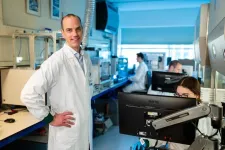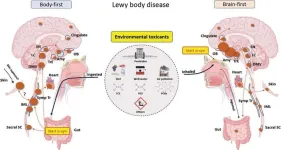New study shows effect of socio-economic factors—housing, food, neighborhood—to predict diabetic patients’ risk of heart failure
2024-04-11
(Press-News.org)
CLEVELAND—A recent study by Case Western Reserve University used national data from U.S. military veterans with diabetes to validate and modify a widely accepted model used to predict the risk of heart failure in diabetic patients.
The model, called the WATCH-DM score, is used to predict the likelihood of heart failure in diabetes patients within five years.
But because it overlooks the influence of social determinants of health‚ such as housing, food and a patient’s neighborhood, the researchers used a social deprivation index (SDI), a multi-component summary score, to adjust the WATCH-DM score.
The SDI, introduced by the Robert Graham Center, a group of clinical researchers, can quantify the level of disadvantage in particular areas using food, housing, transportation and community conditions. Prior research demonstrated this score is directly proportional to the level of health disparities observed in communities.
The study identified about 1 million U.S. veterans with type 2 diabetes without heart failure treated as outpatients at Veterans Affairs medical sites nationally in 2010.
Researchers used patient zip codes to obtain their SDI, which was then entered into the risk calculator to determine how likely they would be hospitalized for heart failure within five years.
While the hospitalization rate for heart failure for the whole cohort of more than 1 million patients was 5.39%, this incidence varied from 3% (in the least socially deprived) to 11% (in the most deprived).
Researchers found that, depending on the patients’ other clinical information, adding the SDI into the risk-prediction model could even double the probability of that patient developing heart failure in the next five years.
The team of investigators then optimized the WATCH-DM score for each SDI group using a statistical correction factor and improved its predictive accuracy across the whole range of the social determinants of health.
“We found that adding the SDI enhanced the WATCH-DM score’s ability to forecast risk,” said Salil Deo, an associate professor in the Department of Surgery at the Case Western Reserve School of Medicine, who led the study. “These results highlight the necessity of including social determinants of health in any future clinical risk prediction algorithms. This will increase their accuracy, which will benefit patients by improving their health outcomes.”
This calculator is available to the public from their device for free here.
“We hope our study encourages healthcare providers to adopt a wholistic approach when treating patients in the future,” Deo said. “Understanding and quantifying social inequity is likely the first step we can take toward trying to ensure that it does not affect the health of our patients.”
###
Case Western Reserve University is one of the country's leading private research institutions. Located in Cleveland, we offer a unique combination of forward-thinking educational opportunities in an inspiring cultural setting. Our leading-edge faculty engage in teaching and research in a collaborative, hands-on environment. Our nationally recognized programs include arts and sciences, dental medicine, engineering, law, management, medicine, nursing and social work. About 6,000 undergraduate and 6,300 graduate students comprise our student body. Visit case.edu to see how Case Western Reserve thinks beyond the possible.
END
[Attachments] See images for this press release:

ELSE PRESS RELEASES FROM THIS DATE:
2024-04-11
RESTON, Va. — A new set of maps that document the movements of ungulates was published today in the fourth volume of the Ungulate Migrations of the Western United States. The maps in this collaborative U.S. Geological Survey report series reveal the migration routes and critical ranges used by ungulates, or hooved mammals, in the western U.S., furthering scientists’ understanding of the geography of big game migrations.
The new volume, “Ungulate Migrations of the Western United States: Volume 4,” documents 33 mule deer, ...
2024-04-11
Can Jos Malda crack the code of cartilage?
In our aging society, healing joint problems is becoming increasingly important. To do this, cartilage damage must become repairable. But so far it has proven impossible to recreate the intricate internal structure of cartilage. Professor Jos Malda has now received an ERC Advanced grant of €2.5 million to crack that code.
Bringing biology and technology together
Throughout his career, Jos Malda has been concerned with the interface between biology and technology. It took him from studying Bioprocess Engineering in Wageningen to ...
2024-04-11
A recent Mayo Clinic study published in Alzheimer's & Dementia: The Journal of the Alzheimer's Association investigated lucid episodes in people living with later stages of dementia, providing insights into how these occurrences reveal themselves.
The findings showed that 75% of people having lucid episodes were reported to have Alzheimer’s Disease as opposed to other forms of dementia.
Researchers define lucid episodes as unexpected, spontaneous, meaningful and relevant communication from a ...
2024-04-11
11 April, Prague, Czech Republic—Glen Kelley’s journey as a heart transplant recipient came full circle today in Prague, as he addressed attendees of the Annual Meeting and Scientific Sessions of the International Society for Heart and Lung Transplantation (ISHLT), including members of his own care teams.
As a high school senior outside of Peoria, Illinois, Kelley was diagnosed with stage-4 Hodgkin’s lymphoma and underwent eight months of chemotherapy and radiation. After 10 months in remission, the ...
2024-04-11
The nose or the gut? For the past two decades, the scientific community has debated the wellspring of the toxic proteins at the source of Parkinson’s disease. In 2003, a German pathologist, Heiko Braak, MD, first proposed that the disease begins outside the brain. More recently, Per Borghammer, MD, with Aarhus University Hospital in Denmark, and his colleagues argue that the disease is the result of processes that start in either the brain’s smell center (brain-first) or the body’s intestinal tract (body-first).
A new hypothesis paper appearing in the Journal of Parkinson’s ...
2024-04-11
Professor Jill Walker Rettberg, Co-Director of the Centre for Digital Narrative at the University of Bergen, is awarded an ERC Advanced Grant for the project AI STORIES. The grant consists of 2.5 million Euro over 5 years. This is Rettberg's second ERC Grant.
“The AI STORIES project builds on the premise that storytelling is central to human culture, with narratives shaping our understanding of the world. We will study artificial intelligence and how it creates new narratives,” says Rettberg.
Generative AI has been dubbed ...
2024-04-11
A major new research project will investigate how and why groups of animals from the same species fight one another.
By focussing on warlike species – mongooses and termites – researchers aim to understand how evolution can lead to extreme aggression between groups, the consequences of this and the factors that can lead to peace.
The results will help to explain why violence between rival groups evolves in some species but not others, or between some groups and not others – with implications for our understanding of human evolution.
The research team, led by Professor ...
2024-04-11
[Vienna, April 11, 2024] – The European Research Council (ERC) has awarded an Advanced Grant to Mirta Galesic, a resident scientist at the Complexity Science Hub (CSH), to study the intricate workings of collective adaptation. The project aims to provide insights into why collectives – from families to entire societies – can be stuck in deadlocks about important problems, such as resolving long-standing political conflicts; or why they sometimes appear incapable of finding seemingly obvious solutions, such ...
2024-04-11
Fukuoka, Japan—Kyushu University researchers have shed new light into a critical question on how baby stars develop. Using the ALMA radio telescope in Chile, the team found that in its infancy, the protostellar disk that surrounds a baby star discharges plumes of dust, gas, and electromagnetic energy. These 'sneezes,' as the researchers describe them, release the magnetic flux within the protostellar disk, and may be a vital part of star formation. Their findings were published in The Astrophysical Journal.
Stars, including our Sun, all develop from what are called stellar nurseries, large ...
2024-04-11
Researchers have evaluated different types of pig farming – including woodland, organic, free range, RSPCA assured, and Red Tractor certified, to assess each systems’ impact across four areas: land use (representing biodiversity loss), greenhouse gas emissions, antibiotics use and animal welfare. Their study concludes that none of the farm types performed consistently well across all four areas – a finding that has important implications for increasingly climate conscious consumers, as well as farmers themselves.
However, there were individual farms that did perform well ...
LAST 30 PRESS RELEASES:
[Press-News.org] New study shows effect of socio-economic factors—housing, food, neighborhood—to predict diabetic patients’ risk of heart failure






